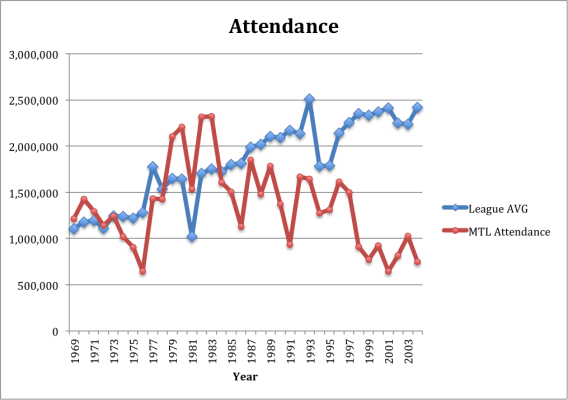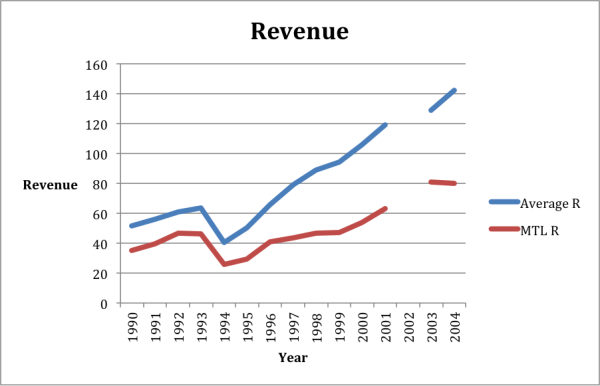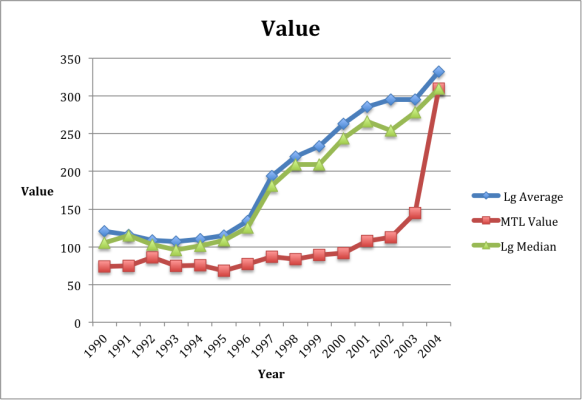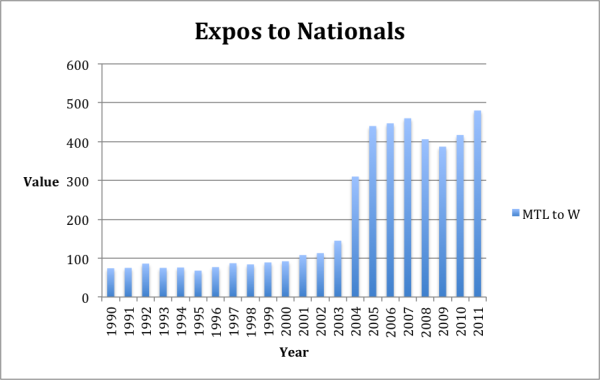Making the Case Against Baseball in Montreal
Through a lot of backroom deals and schemes, which are beautifully illustrated in Jonah Keri’s Up, Up, and Away, mayor Jean Drapeau was finally able to get Montreal, and Canada, a professional baseball team. The Expos were the first baseball franchise to be situated outside of the US. They were part of Major League Baseball from 1969 to 2004; in 2004 they relocated to Washington and became the Washington Nationals.
Throughout most of its history, baseball in Montreal has been a struggle, not just on the field but also off it. In fact, just getting a suitable stadium for the team was a headache. The Expos had to play their first seven years in a Triple-A ballpark called Jarry Park, which could only seat 28, 500 people. The stadium was less than ideal, it wasn’t a dome, and due to Montreal’s cold weather, many games in April and September had to be played on the road.
In 1977, however, the Expos finally got a new Stadium, Olympic Stadium. The unfortunate part, however, for the Expos, was that the primary designs of the stadium were for the Olympics and not baseball. In fact the Stadium, while a dome, was a disaster, in not just its facility but it’s location. It was located completely out of the way, and far from downtown. Charles Bronfman, owner and majority shareholder, often tried to get a new stadium in downtown Montreal, but was never successful. This was probably one of the most significant impediments in the Expos success as a franchise.
The Expos were often poor on the field, but more importantly, they were poor as a business, creating very little revenue (as compared to other major league franchises). They were also, as it seemed, always rebuilding, never being able to sign valuable free agents, and never having a high payroll. There attendance also wasn’t exactly great.
What now follows is an evaluation, of the Expos historical value as a franchise. The problems? Well there are several, one and perhaps the most important to remember, is that teams are privately owned, and therefore are not obliged to disclose any of their financial information. This makes evaluating a team’s overall value very difficult, but not impossible.
Most of you are probably familiar with Forbes. The problem, however, is that I was only able to find Forbes data from 1990 to 2014. I also was only able to find data on payroll, from 1985, on-word, leaving me essentially only with attendance to look at from 1969 to 2004. Attendance, and let me make this clear, is not the best way of measuring a franchise’s value, but since it’s the only data source I could find before 1985, I thought I’d use it. So, below is a chart comparing the Expos attendance history to league average.

For most of its history, the Expos attendance was below average. A couple of other important elements to note are that in 1981, it was a labor-shortened season. That’s why you see the league wide drop in attendance. In 1998 also, while the league attendance was starting to rise, the Expos dropped dramatically. Perhaps this had something to do with the trade of Pedro Martinez to the Red Sox, in the 1997 offseason. Perhaps it had something to do with the franchise rebuilding, yet again, or perhaps there was still some lingering frustration from the 1994 season. None of this is certain, what is however is after 1996, Expos fans stopped showing up.
The goal though is not to gain a sense of attendance, but rather to get a sense of the franchise’s value. Attendance, in that matter has a number of shortcomings. It doesn’t tell us anything about the overall expenses, revenues, ticket sales, TV deals, income, ect… Rather, what it does is give us a sense of the fan’s interest in the team (though not entirely as it doesn’t consider TV ratings). While there seems to have been a significant interest in the team in the mid to low 80’s, the overall interest in the team tends to have been very minimal.
As I’ve mentioned because teams are privately owned enterprises, I had to rely on Forbes value system, which is only available from 1990 on-wards. This will skew the data. For example, from 1979 to 1990 was the Expos most successful era. During that time they only had two losing seasons, which coincided with their first and only playoff berth in 1981.
That being said, a team’s success on the field does not always translate to value. We should therefore not assume that since the Expos had good teams from 1979 to 1990 that the team’s value had risen significantly, if at all. Just take a look at the Rays and the A’s, both teams have won a lot of games, the last few years, and yet Forbes still ranks them among the lowest teams in value.
Also many of you might be wondering what goes into Forbes’ valuation process? How accurate is it? These are valuable questions and concerns. While there isn’t a ton of information out there on these issues, John Beamer did write an article in 2007, for The Hardball Times, which takes a look at how accurate Forbes’ valuation is and what goes into it. If you’re too lazy to read it, than just understand this, “The variance between the purchase price and the Forbes’ valuation averaged 20%…” also “The primary axis of valuation is team revenue, which includes things such as ticket sales, TV money, sponsorship, revenue sharing, concessions, parking and a myriad of other schemes that franchises use to wheedle money from their fans”.
In determining the value, Beamer looked at “recent deals” which ranged from years 1992 to 2006 where only two team values were past 2004 (Brewers and Nationals). Considering most of the data we will be looking at will be from years 1990 to 2004, Beamer’s valuations should not be considered outdated.
So considering that Forbes’ main valuation process is through revenue, that’s where we’ll go next. Below is a chart that compares Montreal’s revenue from 1990 to 2004, compared to league average. An element to note, the 2002 data for revenue was not available, that’s why you will notice a break in the graph.

As you can probably tell, Montreal was always, below average when it came to revenue, and the gap seemed to be getting wider and wider as the years went on. It is also very disappointing that the 2002 data point was not available. There seems to be some kind of break or shift that happened that year, which would have been interesting to look at.
Even though revenue is the major contributor to value, it also states in Beamer’s article that “Major League Baseball franchises are typically valued at somewhere between 2-3x revenues”. To see the evidence of this, again read John Beamer’s article.
So now lets get to the moment you’ve all been waiting for, the Expos franchise value, compared to league average. I also included the median in the chart below. Why? Well in order to avoid teams that are skewing the data too heavily one way or another, such as the Yankees, the median seemed like a useful tool to add, although as you will be able to tell, there wasn’t a significant difference between the median and average.

A lot of you might notice the sudden increase in value for the Expos, in 2004. Well, the Forbes’ valuations for 2004 came after the 2004 season. Thus the franchise was going to officially be the Washington Nationals, which immediately increased the team’s overall value.
Some of you at this point might be wondering how can value increase so significantly? Well, in order to understand what this means, I recommend you read John Beamer’s The Value of Ball Clubs (Part 1) and go to the valuation 101 section. If you don’t want to do that, then I’ll just summarize the concept. Basically what one is trying to do, in valuing any type of business, is trying to work out the value of today, in conjunction with the amount of cash flow a business or team will provide it’s owners in the future.
Ok, now that you got that, let’s look at one final chart, I promise! Here we’ll look at the Expos overall franchise value beginning with 1990, but will also include the Nationals value until 2011, in order to see how the move to Washington has paid off.

Now look at that huge increase in team value. Basically what Major League Baseball did, was turn one of it’s least profitable teams into an above average team. In fact, from 2003 to 2004 the team’s value changed 114 %. This was by far the biggest change in one-year value of any franchise. The next highest one-year percentage change, for 2004, was the Phillies at 39%. In fact, since Forbes has made their data available I have never found a one-year value % change as high as this one.
This looks like pretty damming evidence of the Expos franchise, and it is. Montreal’s first crack at a Major League Franchise was not a successful one. This, however, does not mean that it wasn’t important. Montreal was the first Canadian franchise to ever get a baseball team and it opened the doors for a team to come to Toronto.
That being said,, the prospects of Montreal getting a new team does look bleak, even after Rob Manfred’s comments, “Montreal’s a great city. I think with the right set of circumstances and the right facility, it’s possible.” Manfred’s comments were positive, when addressing Montreal, however, they were relatively vague. The notion of the right set of circumstances, for example, could mean anything. Also, for Montreal to get a team another team needs to re-locate and when addressing a team’s relocation, a popular team has been the Tampa Bay Rays.
The problem is that the Rays aren’t moving anytime soon. As Eric Macramalla points out in his article, Dream Killer: Sorry Expos Fans, The Tampa Bay Rays Aren’t Moving To Montreal. Basically the Rays aren’t going anywhere because they signed a Use Agreement, which “prevents the team from moving out of Tropicana Field and calls for potentially catastrophic monetary damages should the Rays abandon the stadium before its deal is up in 2027”. As for baseball expanding, well I haven’t exactly herd or read that baseball expects to expand anytime soon, so it doesn’t look like that is going to happen.
Then there’s the right facility, well just about every owner of the Expos has tried unsuccessfully to get a new stadium, and one downtown. At this point (and this is my opinion and should be taken that way), Montreal would need to construct a stadium downtown in order for them to receive a team. Which, given its history of incompetence in that matter seems unlikely.
Finally, could Montreal someday get a baseball team? Yes, when that will be, I don’t know, probably not anytime soon. Therefore Expos fans should not be holding their breaths. At this point, as it concerns a Major League Baseball Franchise there really is no evidence that Montreal can sustain a successful team. That being said, if I were Major League Baseball, I’d start by installing a Minor League Team and see how it goes. If it’s successful and fans are showing up, then perhaps re-consider.
References:
- John Beamer Articles for The Hardball Times: Part 1 http://www.hardballtimes.com/measuring-managing-the-value-of-ballclubs-part-1/
- Part 2: http://www.hardballtimes.com/measuring-managing-the-value-of-ballclubs-part-2/
- SABR Business of Baseball Committee, which provided most of the Forbes data. Also a great source of economic data, for baseball research.
- Eric Macramalla’s article “Dream Killer: Sorry Expos Fans, The Tampa Bay Rays Aren’t Moving To Montreal”.
- The Biz of Baseball for providing additional Forbes data.
- Ben Nicholson-Smith article Manfred: Return to Montreal ‘Possible’ for MLB, for the Manfred quote.
- Jonah Keri’s Up, Up, and Away.
- Attendance data was found at Baseball Reference.
Julien Assouline is a journalism student at Ryerson University, and writes for Baseball Prospectus Milwaukee. Follow him on Twitter @JulienAssouline.
“due to Montreal’s cold weather, many games in April and September had to be played on the road.”
Where would they play? Would they play in the stadium of the “visiting” team?
not necessarily ‘Home Games’ played on the road. More likely, most of their schedule is where they are the visitors at the other park, for April and Sept and most of their home games played in the summer (may thru aug).
Cidron you got it. Sorry if that wasn’t clear, but most Expos home games at that time were bunched up in May, June, July, and August
The Expos were much closer to league average in per-game home attendance in 1994 than the graph would make it appear. The problem with showing overall home attendance for a strike-shortened season is that not every team played the same number of home games. In fact, the Expos had played 10 fewer home games than road games at the time of the strike. Fans were warming up to the team by mid-summer, and they drew 30,000+ for their final 7 home games.
I actually recorded the data and created a graph for attend/g. The difference, however, was so small i decided no to include it, also would have felt redundant. If you wish to see the graph hit me up on twitter for my email and all send it to you.
Thank you for the article, but your statement that there is no evidence that baseball can succeed in Montreal is not supported by what you presented. You noted several significant issues that constitute obstacles to its success but you did not at all make the case of there being no evidence. You showed that the franchise’s revenue has been much better since moving to DC. But before the move, Bud Selig expressed much skepticism that the franchise would be better off, since 2 prior DC franchises had already been unsuccessful enough to move elsewhere and because of his, and many others’, perception the DC was not a good baseball town. A new stadium w a dome that actually works is essential of course. But just because efforts to build a new stadium, downtown or elsewhere, failed in the past doesnt mean they will fail in the future. DC also had a very difficult time finding a suitable location for and getting the funding for a new stadium before it finally happened. Montreal’s metropolitan area is larger (3.8 mil +) than those of 11 existing MLB cities, so it would appear that it it has the population to support an MLB team, if the people of Montreal want one. Success depends in large part on how badly they want a new team and how willing they are to expend the necessary funds for it. I dont live in Montreal so I dont how strong the local sentiment is for another team or whether a wealthy enough ownership group is interested. Those I think are the key factors, not the other things you mentioned.
And you failed to to note the one great advantage Montreal would seem to have over other potential expansion cities, which is that a team there would not greatly infringe on the territory of existing MLB team(s). This I see as the biggest obstacle in MLB expanding anywhere. Yes, technically Quebec is in Toronto’s territory. But all of Canada is considered Toronto’s territory, and most of Canada, including Yukon and NW Territories, is considered theirs exclusively (!!!). Toronto would seem to have less of a case than practically anywhere else that an expansion team in their defined territory would damage them significantly. Manfred’s interest in pursuing Montreal as an expansion city would seem to indicate that he considers the infringement issue to be less of a problem there. And any dispute probably could be worked out like it was between DC and Baltimore.
Thanks for the comment rhd. The evidence that I presented was Montreal’s poor value throughout it’s entirety as a franchise. In not a single year since 1990 was the franchise value over the league average. That was the main, not the only, evidence of why baseball didn’t work in Montreal. As it pertains to a new stadium, that’s not really the main issue; the main problem is that A. Tampa Bay isn’t going anywhere and B. As far as I know baseball doesn’t plan to expand. That’s why Montreal isn’t getting a team anytime soon. The stadium is merely another road block and a complicated one. Montreal’s shown no signs that they are willing or even plan on building a stadium downtown anytime soon. Montreal can hold a baseball team under the right circumstances yes, but those circumstances need to be met, and they never met those circumstances at any point in during there existence.
Your final argument is also predicated on the fact that baseball will expand, which is simply not the case.
I am on my way to help you understand right after I finish cursing this pitcher’s UCL.
Love your work Jonah and looking forward to it.
I don’t think anyone would argue that a team in Montreal would come in and be a big broker. But it’s a huge difference between having a team be above-average value, and the city being able to hold a team.
Up through 1994, Montreal was essentially a small to mid-market team. Then after 1994, they plummeted. Yes, it’s not a good sign that the fans mostly abandoned the team, but speaking as an Expos fan, it truly tested your loyalties. Especially in the late 1990s, when everyone is telling you they want to get rid of your team, and the league offices essentially do everything in their power to kill the team, it’s hard to fault the city too much.
For baseball to succeed, Montreal needs only 2 things: A good stadium in a good location, and an owner who cares and won’t abandon the team. Without those 2, there’s no chance of a team, but if they can line those up, then Montreal absolutely can support a team.
According to a 2011 Business Journals study, there were only two North American cities with sufficient total personal income to support a major league baseball franchise, should MLB decide to expand or relocate: Riverside-San Bernardino, California and Montreal. That’s all. Sooner or later there will be sufficient motivation to put a team in Montreal. And there really is no reason to think that the franchise couldn’t work, as long as it has a strong ownership group and a modern stadium in a great location.
Is this the article your referring to “Baseball has few options for expansion” ?
markets”http://www.bizjournals.com/bizjournals/on-numbers/scott-thomas/2011/08/baseball-has-few-options-for-expansion.html?page=all
I’m going to assume it is because you didn’t provide the link and it discusses the points you’ve mentioned and it was written in 2011.
And I quote: “Only one market — Riverside-San Bernardino, Calif. — has an income base that’s large enough to support a new MLB team, according to an On Numbers study.”
“Seven other markets have borderline potential, based on an analysis of total personal income (TPI). Prominent in that group are a city that has already lost an MLB franchise (Montreal) and another (Las Vegas) whose gambling industry makes baseball officials very nervous.”
Presuming this is the article your talking about your seriously mis-representing the article.
That being said out of the other group Montreal did have the second highest rating. Montreal definitely has the population to support a major league team. The problem is getting the right owner and getting a stadium downtown, which are two huge road blocks. Especially the stadium being downtown. Every owner the Expos had tried to get a new stadium none were successful
I meant financial capacity sorry not population, even though it has both. Financial and populous to support a team.
Yes, that was the study, although please check out the links in the article you cited to get at the real data. I don’t think I either misrepresented or misunderstood it. Riverside-San Bernadino had a 100% rating and Montreal had 97%. Virtually a dead heat, since their “capacity index” is a scale arbitrarily calibrated 0-100. No other city, including Las Vegas, was even close. If you look at the numbers, you’ll see that the only reason Riverside was rated slightly more highly than Montreal is that they have no pro sports franchises, whereas Montreal obviously has an NHL team that drains some of the available discretionary spending. But a better comparison, in my view, would be between Montreal ($127.73 B in personal income) and Baltimore ($126.24 B). Baltimore manages to support not only the Orioles, but also the NFL Ravens. I see no reason why Montreal can’t support both MLB and NHL teams, provided that they are given a reasonably well run baseball team to support.